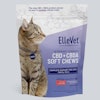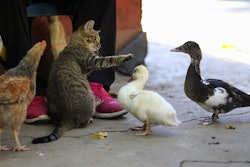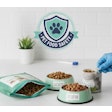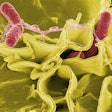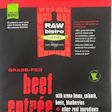
The SARS-CoV-2 coronavirus, which causes COVID-19 disease, seems to be zoonotic, meaning the virus moved into humans from wild animals. Diseases can also pass from wildlife to livestock, zoo animals and companion animals, including a small number of dogs and cats that caught COVID-19. This phenomenon of one non-human species passing a disease to another can be called spillover. Those animals don’t need to be in direct contact with each other for spillover to occur.
On July 25 and 31 of last year, health officials confirmed highly pathogenic avian influenza A(H5N1) infections in two cat shelters in Seoul, South Korea. A team of researchers examined this outbreak and published a summary in Nature Communications, along with suggestions for controlling future cross-species disease transmission.
“The influenza A(H5N1) outbreaks in the cat shelters in South Korea, along with an increasing number of reports of influenza A(H5N1) infection in mammals, suggest the need to enhance the effectiveness of infectious disease surveillance and prevention in any settings where a group of potentially susceptible animals are kept in close contact,” they wrote. “This is particularly important for groups of animals that typically are not covered by regulatory efforts aimed at maintaining or improving animal health and welfare standards. These animal groups could not only provide environments for cross-species viral transmission, promoting zoonotic risk, but could also serve as sentinels for detecting such events, thereby offering opportunities to assess and then mitigate such risk.”
H5N1 avian flu can spread to and kill humans. Between 2003 and 2023, the World Health Organization received 882 reports of human infection with H5N1 bird flu in 23 countries. Of these, 461 cases were fatal. Interspecies transmission of diseases can be fatal for the animals as well.
South Korean bird flu outbreak among shelter cats
In the case last year at one of the cat shelters in South Korea, 38 out of the 40 infected cats died within a month. The shelter cats had all been kept indoors, so it seemed unlikely that wild birds had spread the pathogen to the cats. Instead, the virus may have spread to the cats through their food. Investigators with South Korea’s Ministry of Agriculture, Food and Rural Affairs (MAFRA) detected influenza A(H5N1) virus in cat food from one of the shelters. The cat foods were Balanced Duck and Balanced Chicken manufactured by Nature's Raw at its facility in Gimpo, west of Seoul. The Ministry stated that the company had failed to follow necessary sterilization steps since May 25 due to an equipment malfunction. MAFRA officials then ordered the recall of all cat food batches considered at risk of harboring the virus. Approximately 13,200 units had already been sold to 286 pet owners. However, these pet owners reported no signs of infection in their cats.
The virus may have entered the cat food stream during an outbreak of the virus on South Korean poultry, including duck, farms that lasted until April 2023. While it seems likely that these farm infections may have been the source of the virus that infected the cats, the authors of the Nature paper noted that no conclusive evidence has been released by MAFRA. It is also unknown if the cats also spread the virus among each other, or if the disease always came from the cat food.
No humans in contact with the cats have tested positive for avian influenza. Although cats can contract highly pathogenic avian influenza, epidemiologists believe cats are not a significant vector for the disease and do not play a major role in transmitting avian influenza to people or other animals.
Avian influenza infection of cats
Avian influenza or bird flu naturally spreads among wild aquatic birds worldwide and can infect domestic poultry and other bird and animal species, according to the World Health Organization. Highly pathogenic avian influenza is a subtype of the virus. It can cause severe illness and high mortality rates in domestic poultry and wild birds. The viruses can devastate poultry industries and have economic repercussions due to trade restrictions. Some varieties, including H5N1, can cross species barriers and may cause severe illnesses in mammals.
In June, 2023, the IHR National Focal Point of Poland notified the World Health Organization of unusual deaths in cats across the country, suspected to be caused by highly pathogenic avian influenza. As of July 11, 47 samples had been tested from 46 cats and one captive caracal. Twenty-five samples tested positive for H5N1 avian influenza. Fourteen cats were euthanized. A further 11 died with the last death reported on June 30. Some cats developed severe symptoms, such as labored breathing, bloody diarrhea and neurological signs. Some of the cats deteriorated rapidly and died. In total, 20 cats had neurological signs, 19 had respiratory signs and 17 had both signs.
Monitoring and controlling disease spillover among pet cats and dogs
The outbreak of H5N1 avian influenza among the shelter cats was a rarity. The fact that the cats were all in one place may have been a major reason why the disease was discovered as the culprit, the study authors wrote. In individual homes, a cat infected with avian flu might have been diagnosed as suffering from another more common disease. Multiple cats getting the same disease were more easily observed in a shelter. Likewise in a home, the virus wouldn’t have had the opportunity to spread among various animals, if that indeed happened.
Considering the South Korean outbreak of avian influenza A(H5N1), the scientists made suggestions to avoid future disease spillover and reduce zoonotic potential.
1. Require pet shelters to systematically record adverse animal health events at individual animal and group levels. In outbreak situations, pet shelters should also record environmental factors (e.g. access to/from wildlife, and introduction of new animals) and husbandry conditions (e.g. food and water source).
“In the event of cross-species viral transmission, this information will help to better understand the source of infection and thus inform the implementation of preventive and control measures,” the scientists wrote. “Such a recording practice appears to have been lacking in these particular settings, very much in contrast to conventional livestock farming where the recording is routinely practiced.
2. Training shelter staff to report any unusual clinical signs or health trends among animals in the shelter. Animal health authorities need to precisely define reporting criteria and ensure shelter staff are familiar with those criteria.
3. The potential for undercooked poultry to transmit avian influenza justifies prohibiting or limiting the feeding of uncooked meat to animals kept for non-conventional production purposes, such as pet shelters and fur farms, and those in non-agricultural settings. These restrictions could minimise the risk of cross-species transmission of influenza A(H5N1) virus and other viruses.
4. Continue discussing how to implement measures to prevent and control cross-species viral transmission.
“It is crucial to involve all relevant stakeholders in this discussion, particularly the staff of the aforementioned animal settings, as their understanding of the implications of animal keeping for animal and human health might be less than amongst those involved in conventional livestock farming,” they wrote.


